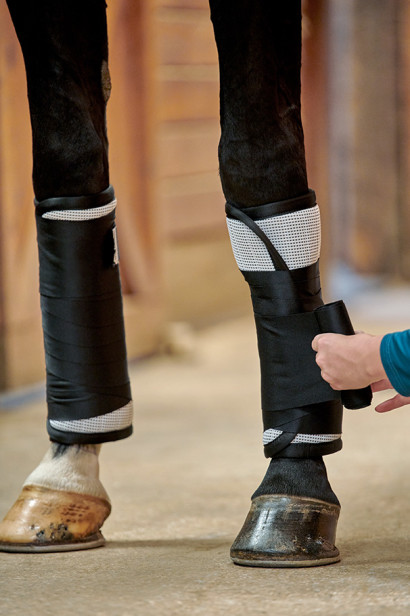Windpuffs in Horses – Identifying Windgall Leg Swellings
Updated February 1, 2024 | Reviewed By: Joan Maree Hinken, DVM, CVA, CVSMT
What are Windpuffs in Horses?

Windpuffs or windgalls are common laymen’s terms for a condition that is characterized by fluid at the back of the horse’s fetlock joint. This fluid is in the digital sheath which surrounds the Deep Digital Flexor Tendon (DDFT) and Superficial Digital Flexor Tendon (SDFT).
These tendons run down the back of the horse’s lower legs – the DDFT is proximal (closer) to the fetlock joint while the SDFT is distal to the fetlock joint (meaning it’s slightly higher up the leg than the DDFT). They insert in the mid-pastern region in both the horse’s front and hind legs.
The tendon sheath is lined with a synovial membrane that produces or secretes synovial fluid, which allows the tendons to slide smoothly over the back of the fetlock joint. If the digital sheath becomes inflamed (called digital sheath synovitis) it will secrete excess fluid. This results in distension of the tendon sheath, which may present as fluid swelling that extends from mid-cannon bone to mid-pastern at the back of the fetlock.
Windpuffs can occur in a single leg, both front legs, both hind legs, or in all four legs.
How to Know When Swellings are NOT Windpuffs
Keep in mind that the soft, cold swellings we call windpuffs are a different condition than swelling from fetlock joint inflammation. Although, in certain cases, there can be swelling in both the fetlock joint and the digital sheath at the same time. If you feel heat or a pulse associated with swelling on your horse's leg, call your veterinarian.
Ask the Vet Video on Windpuffs
What Causes Windpuffs in Horses?
Windpuffs are caused by an excessive amount of synovial fluid in the digital flexor tendon sheath in the front and hind legs. It is an indication of excessive strain on the digital flexor tendons caused by hyper-extension of the fetlock joint.
Windpuffs are a “wear and tear” type of injury that can progress over time. The clinical signs of the injury depend on the degree of inflammation.
Windpuffs are commonly found in older horses that have had careers in competitive sport such as jumping and dressage or any activity that causes the fetlock joint to undergo repetitive loading and hyper-extension.
Hoof imbalance, whether from the trim or the shoe, can cause windpuffs. Horses that have long toes or low heels are likely to have hyper-extension of the fetlock joint, as will horses with long, excessively sloping pasterns or long, very straight pasterns.
Windpuffs and Lameness
Mild to moderate effusion (fluid accumulation) of the digital sheath is generally not painful to the horse. Palpation of the soft, fluid-filled windpuffs is not painful, nor flexion of the fetlock joint.
Normally, horses with windpuffs will not be lame. However, if the ailment progresses to involve the digital flexor tendons, annular ligament, and form adhesions in the tendon sheath, your horse will become lame.
Windpuffs can also occur if there is a lameness in another limb, where the affected leg has increased loading causing the fetlock joint to be chronically hyper-extended.
How to Treat Windpuffs in Horses

Treatment for windpuffs consists of 3-4 weeks rest from work at onset of the fluid accumulation. Cold therapy such as hosing or icing your horse’s legs, as well as bandaging for support can be beneficial. Turnout time is not recommended during the early stages of a windpuff’s development as it will aggravate the inflammatory response.
Your veterinarian may prescribe anti-inflammatory medications as well as intramuscular injections of a polysulfated glycosaminoglycan (PSGAG, such as Adequan®). The horse’s foot balance should be addressed, and any other lameness should be treated.
Older horses with long-standing tendon sheath distension should be monitored to ensure the windpuffs do not progress or become larger. In these horses, windpuffs are considered blemishes and most often do not affect the horse’s performance or quality of life. A good management practice for horses who’ve had long-term windpuffs is to turn them out to pasture for as much time as possible – all day, overnight, or 24/7 if possible – to alleviate swelling by promoting circulation.
If left untreated and the cause not addressed, windpuffs can progress to an ailment that may lead to mild to severe lameness. The horse could resist flexing the affected limbs’ fetlock joint. There will be damage to the digital flexor tendons, adhesions to the digital sheath, and thickening of the palmar/plantar annular ligament.
Supplements That May Lend Support
The right supplement can help support a normal inflammatory response in your horse’s body. Ingredients such as Devil’s Claw, yucca, boswelia, tumeric, and omega-3 fatty acids can help manage discomfort associated with normal exercise and aging.
For comprehensive support, oral glucosamine can be beneficial for protecting joints by supplying the building blocks to produce new, healthy tissue. MSM has also been used successfully as it’s key in supporting healthy joints, tendons, ligaments, hooves, and other tissues of the body.
Horse Owner FAQs on Windpuffs
What role does a horse’s conformation play in whether they develop windgalls?
Any conformation that causes chronic hyperextension of the fetlock joint may play a role in the development of windpuffs. Examples include the long sloping pastern, the long straight pastern, and the long-toe/low-heel horse.
Can you ride a horse with windpuffs?
In most cases, once the digital tendon sheath is no longer undergoing active inflammation the horse can be ridden. It usually takes 3-4 weeks for the initial inflammatory reaction to subside.
How do you get rid of windpuffs in horses?
Once the windpuffs have reached the chronic stage, there is little to be done to eradicate them. Standing wraps, poultices, and/or sweating the lower limb will result in a temporary loss of fluid for a few hours, but it will return. Your veterinarian can drain the fluid and inject steroids, hyaluronic acid, or various regenerative medications, but the fluid eventually returns.